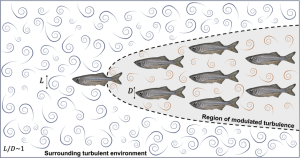
Tour de France 2024 favorites Jonas Vingegaard, Tadej Pogačar, and Primož Roglič understand the power of the peloton, in which riders cluster on the route to conserve energy and shield themselves from wind resistance. According to a multi-university team of researchers that includes Johns Hopkins engineers, fish do this too—and for a similar reason.
“Schools of fish are nature’s pelotons,” said study co-author Rui Ni, an associate professor of mechanical engineering at the Whiting School of Engineering. “They are doing what pro cyclists like those in this week’s Tour de France have been doing for years: forming a group to move more efficiently.”
 Working with Michael Calicchia, PhD candidate in mechanical engineering, and researchers from Harvard and Princeton, Ni found that by swimming in schools, fish reduced the total energy they expended by up to 79% compared to solitary fish swimming at high speeds in turbulent water. Why? Because just as in a Tour de France peloton, the group formation protects individuals—in this case, from the force of whirlpools or eddies in the water.
Working with Michael Calicchia, PhD candidate in mechanical engineering, and researchers from Harvard and Princeton, Ni found that by swimming in schools, fish reduced the total energy they expended by up to 79% compared to solitary fish swimming at high speeds in turbulent water. Why? Because just as in a Tour de France peloton, the group formation protects individuals—in this case, from the force of whirlpools or eddies in the water.
The team’s findings—the first study investigating the effects of turbulent flow on fish schools—appear in PLOS Biology.
The team measured the total energy expenditure (aerobic and anaerobic) of eight giant danio encountering eddies as they swim. The researchers found that, when encountering higher turbulence levels, schools of fish reduced their total energy expenditure by 63% to 79% compared to solitary fish. They also noted that the school altered its shape to become more efficient when it encountered greater turbulence.
In addition, the scientists found that fish swimming in schools used nearly eight times less anaerobic energy than solitary swimmers navigating turbulent waters and recovered from the exertion almost twice as fast as fish swimming alone. (Anaerobic energy is produced in the absence of oxygen when the body needs a quick burst of energy, unlike aerobic energy, which refers to energy produced using oxygen that the fish extract from the water using their gills.)
“We also noticed that a solitary fish increases its tail beat amplitude when encountering turbulence, whereas fish within the school don’t alter their swimming dynamics from that used in non-turbulent conditions,” Ni said. “The school itself acts as a shelter, much like a pack of competitive cyclists mitigating air resistance.”
Other contributors were Yangfan Zhang and George V. Lauder from Harvard and Hungtang Ko from Princeton.